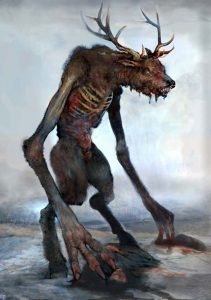Humans are selfish beings. They want to do things for there own pleasure. We tend to be free-spirited, some more than others which can cause trouble and obstacles for oneself or to the people around us. Monster stories reflect ourselves and the cultures that created them and most importantly can teach us morals.
Nowadays, when you hear the word “monster” you might not think of a scary creature because of how movies portray them, or maybe you might have forgotten the terrifying monsters that exist in your culture as you grow up. Well, the Algonquian monster will remind you how real these monsters may seem. The Wendigo is a monster that draws chills down some peoples spine by just hearing someone say the name. It is a monster most Minnesotans fear. The Wendigo or Windigo is a monster or spirit believed in a variety of indigenous tribes in North America who are Algonquian speaking. The Wendigo is a man-eating monster who is always looking for its next victim, they are known for their speed. It is believed that someone overpowered by greed can become a Wendigo. As well as someone who is a cannibal is considered a Wendigo. The monster showed the beliefs the culture of the Algonquian people had. It taught the importance of not being cannibals when in starvation, selflessness and a community.
Monsters seem to be a part of every culture. It gives us something we can all come together with and relate too. Klosterman writes about this for American culture. Klosterman states “When we think critically about monsters, we tend to classify them as personifications of what we fear…It’s easy to project a symbolic relationship between zombies and rabies (or zombies and the pitfalls of consumerism)…(Klosterman 2).’ The fear of zombies in American Culture helps us be aware of how much we are consuming things like media.
In my own culture, which is Ecuadorian culture. The story of the “Mariangula” is a common monster/spirit.The monster is a ghost who takes disobedient children. As a child, I was afraid the Mariangula would come and disturb my sleep to take me for not listening to what my mother told me to do. This monster teaches those who grew up in Ecuadorian households the importance of obeying our parents.
Cultures created monsters to teach morals. However, don’t let the cute monsters media now portrays forget how real they can be.
Bibliography
“Windigo.” The Canadian Encyclopedia, 9 Sept. 2012, www.thecanadianencyclopedia.ca/en/article/windigo.
Maccauley, Elizabeth. “The Mythology and Misrepresentation of the Windigo.” BackStory, 23 Nov. 2016, www.backstoryradio.org/blog/the-mythology-and-misrepresentation-of-the-windigo/.
Klosterman, Chuck. “My Zombie, Myself: Why Modern Life Feels Rather Undead.” The New York Times, The New York Times, 3 Dec. 2010, www.nytimes.com/2010/12/05/arts/television/05zombies.html.




